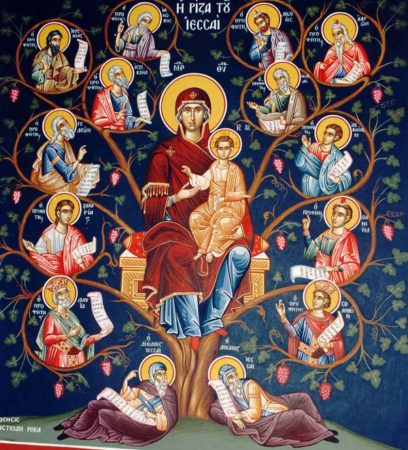Translation from the book:
Στεργίου Ν. Σάκκου, Ἑρμηνεία στό κατά Λουκᾶν Εὐαγγέλιο, τόμ. Α΄,
ἐκδ. «ΧΡΙΣΤΙΑΝΙΚΗ ΕΛΠΙΣ» ΟΡΘΟΔΟΞΗ ΑΔΕΛΦΟΤΗΤΑ, Θεσ/νίκη 2008, σσ. 159-164
(Stergios N. Sakkos [Read CV], A Commentary on the Gospel according to St. Luke, vol. A', pp. 159-164)
In antiquity, all peoples in general preserved their genealogical tree carefully, but the Hebrews were particularly careful to preserve it, as they looked forward to the Messiah’s coming, who would come from a specific tribe and a specific generation. Jesus’ genealogy is mentioned by the evangelists Matthew and Luke; Matthew writes about it immediately before the narrative of Jesus Christ’s birth (see 1:1-17), while Luke at the beginning of his public ministry.
3,23. Καὶ αὐτὸς ἦν ὁ Ἰησοῦς ὡσεὶ ἐτῶν τριάκοντα ἀρχόμενος, ὤν, ὡς ἐνομίζετο, υἱὸς Ἰωσήφ, τοῦ Ἡλί.
3:23 And he was Jesus and was about thirty years old when He began His ministry. He was supposed to be the son of Joseph, son of Heli.
When Jesus began his public ministry, “was about thirty years old”. This age, at which a man combines physical perfection and spiritual maturity, was recognized by the Jewish law as a suitable age for taking up public office. Jesus, of course, already at the age of twelve, had astonished the teachers of the law with his wisdom (cf. 2:47). He waited, however, to reach the appointed age of thirty years. As he endured circumcision and baptism, although it was undoubtedly not necessary for him, so once again he condescended and behaved just as a simple Jew.
People thought that Jesus was Joseph’s son, although in reality he was born "of the Holy Spirit and of Mary the Virgin", as the Orthodox Church confesses in the Creed, and as the archangel Gabriel announced to Mary on the day of the Annunciation (see Lk 1:35).
 3,24-38. τοῦ Ματθάν, τοῦ Λευΐ, τοῦ Μελχί, τοῦ Ἰωαννᾶ, τοῦ Ἰωσήφ, τοῦ Ματταθίου, τοῦ Ἀμώς, τοῦ Ναούμ, τοῦ Ἐσλίμ, τοῦ Ναγγαί, τοῦ Μαάθ, τοῦ Ματταθίου, τοῦ Σεμεΰ, τοῦ Ἰωσήχ, τοῦ Ἰωδᾶ, τοῦ Ἰωαννάν, τοῦ ῾Ρησᾶ, τοῦ Ζοροβάβελ, τοῦ Σαλαθιήλ, τοῦ Νηρί, τοῦ Μελχί, τοῦ Ἀδδί, τοῦ Κωσάμ, τοῦ Ἐλμωδάμ, τοῦ ῎Ηρ, τοῦ Ἰωσῆ, τοῦ Ἐλιέζερ, τοῦ Ἰωρείμ, τοῦ Ματθάτ, τοῦ Λευΐ, τοῦ Συμεών, τοῦ Ἰούδα, τοῦ Ἰωσήφ, τοῦ Ἰωνᾶ, τοῦ Ἐλιακείμ, τοῦ Μελεᾶ, τοῦ Μαϊνάν, τοῦ Ματταθᾶ, τοῦ Νάθαν, τοῦ Δαυΐδ, τοῦ Ἰεσσαί, τοῦ ᾿Ωβήδ, τοῦ Βοόζ, τοῦ Σαλμών, τοῦ Ναασσών, τοῦ Ἀμιναδάβ, τοῦ Ἀράμ, τοῦ Ἰωράμ, τοῦ Ἐσρώμ, τοῦ Φαρές, τοῦ Ἰούδα, τοῦ Ἰακώβ, τοῦ Ἰσαάκ, τοῦ Ἀβραάμ, τοῦ Θάρα, τοῦ Ναχώρ, τοῦ Σερούχ, τοῦ ῾Ραγαῦ, τοῦ Φάλεκ, τοῦ ῎Εβερ, τοῦ Σαλᾶ, τοῦ Καϊνάν, τοῦ Ἀρφαξάδ, τοῦ Σήμ, τοῦ Νῶε, τοῦ Λάμεχ, τοῦ Μαθουσάλα, τοῦ Ἐνώχ, τοῦ Ἰάρεδ, τοῦ Μαλελεήλ, τοῦ Καϊνάν, τοῦ Ἐνώς, τοῦ Σήθ, τοῦ Ἀδάμ, τοῦ Θεοῦ.
3,24-38. τοῦ Ματθάν, τοῦ Λευΐ, τοῦ Μελχί, τοῦ Ἰωαννᾶ, τοῦ Ἰωσήφ, τοῦ Ματταθίου, τοῦ Ἀμώς, τοῦ Ναούμ, τοῦ Ἐσλίμ, τοῦ Ναγγαί, τοῦ Μαάθ, τοῦ Ματταθίου, τοῦ Σεμεΰ, τοῦ Ἰωσήχ, τοῦ Ἰωδᾶ, τοῦ Ἰωαννάν, τοῦ ῾Ρησᾶ, τοῦ Ζοροβάβελ, τοῦ Σαλαθιήλ, τοῦ Νηρί, τοῦ Μελχί, τοῦ Ἀδδί, τοῦ Κωσάμ, τοῦ Ἐλμωδάμ, τοῦ ῎Ηρ, τοῦ Ἰωσῆ, τοῦ Ἐλιέζερ, τοῦ Ἰωρείμ, τοῦ Ματθάτ, τοῦ Λευΐ, τοῦ Συμεών, τοῦ Ἰούδα, τοῦ Ἰωσήφ, τοῦ Ἰωνᾶ, τοῦ Ἐλιακείμ, τοῦ Μελεᾶ, τοῦ Μαϊνάν, τοῦ Ματταθᾶ, τοῦ Νάθαν, τοῦ Δαυΐδ, τοῦ Ἰεσσαί, τοῦ ᾿Ωβήδ, τοῦ Βοόζ, τοῦ Σαλμών, τοῦ Ναασσών, τοῦ Ἀμιναδάβ, τοῦ Ἀράμ, τοῦ Ἰωράμ, τοῦ Ἐσρώμ, τοῦ Φαρές, τοῦ Ἰούδα, τοῦ Ἰακώβ, τοῦ Ἰσαάκ, τοῦ Ἀβραάμ, τοῦ Θάρα, τοῦ Ναχώρ, τοῦ Σερούχ, τοῦ ῾Ραγαῦ, τοῦ Φάλεκ, τοῦ ῎Εβερ, τοῦ Σαλᾶ, τοῦ Καϊνάν, τοῦ Ἀρφαξάδ, τοῦ Σήμ, τοῦ Νῶε, τοῦ Λάμεχ, τοῦ Μαθουσάλα, τοῦ Ἐνώχ, τοῦ Ἰάρεδ, τοῦ Μαλελεήλ, τοῦ Καϊνάν, τοῦ Ἐνώς, τοῦ Σήθ, τοῦ Ἀδάμ, τοῦ Θεοῦ.
3:24-38 the son of Matthat, the son of Levi, the son of Melchi, the son of Jannai, the son of Joseph, the son of Mattathias, the son of Amos, the son of Nahum, the son of Esli, the son of Naggai, the son of Maath, the son of Mattathias, the son of Semein, the son of Josech, the son of Joda, the son of Joanan, the son of Rhesa, the son of Zerubbabel, the son of Shealtiel, the son of Neri, the son of Melchi, the son of Addi, the son of Cosam, the son of Elmadam, the son of Er, the son of Joshua, the son of Eliezer, the son of Jorim, the son of Matthat, the son of Levi, the son of Simeon, the son of Judah, the son of Joseph, the son of Jonam, the son of Eliakim, the son of Melea, the son of Menna, the son of Mattatha, the son of Nathan, the son of David, the son of Jesse, the son of Obed, the son of Boaz, the son of Sala, the son of Nahshon, the son of Amminadab, the son of Admin, the son of Arni, the son of Hezron, the son of Perez, the son of Judah, the son of Jacob, the son of Isaac, the son of Abraham, the son of Terah, the son of Nahor, the son of Serug, the son of Reu, the son of Peleg, the son of Eber, the son of Shelah, the son of Cainan, the son of Arphaxad, the son of Shem, the son of Noah, the son of Lamech, the son of Methuselah, the son of Enoch, the son of Jared, the son of Mahalaleel, the son of Cainan, the son of Enos, the son of Seth, the son of Adam, the son of God.
Comparing this Jesus’ genealogy with that given by Matthew, we find several differences both in the number of the names and in the names themselves. In particular these are the following differences:
1) Matthew begins the genealogy from Abraham and ends with Joseph, Mary’s husband. Conversely, Luke begins from Joseph, he bypasses Abraham and ends up with Adam. This difference is easily understood when we know the purpose of the writing of the two Gospels. Matthew addresses the Jewish Christians, to whom he wants to demonstrate that Jesus, according to the promises, is the seed of Abraham and that he descends from David’s royal line (see Acts 2:30; Rom 1:3; 2 Tim 2:8; Eph 7:14). Luke who is the disciple of Paul, the apostle to the Gentiles, addresses the Gentiles and he writes to the “most excellent Theophilus”. Consequently, he aims to present the universality of the gospel. For this reason, his genealogy reaches Adam, the common ancestor of the human race. He even implies that Adam came into existence directly from God, without any parents. In this way he refers indirectly to the creation of man by God.
2) There are also differences between the two genealogies in the period from David to Joseph. The names Zerubbabel and Salathiel, common to the two genealogies, do not refer to the same persons. Moreover, Luke mentions 42 names in all, while Matthew mentions far fewer, only 28. In both genealogies, of course, there are omissions of names. These are either because there were omissions in the genealogical lists on which the evangelists based their writings, or because the word "son" simply means descendant and not direct son (cf. Mt 1:1; “The book of the generation of Jesus Christ, the son of David, the son of Abraham”).
Julius Africanus, an ancient writer, explained the difference between the two lists as follows: Joseph's natural father was Jacob, while his legal father was Eli according to the law of “ἐπιγαμβρεύσεως” (see Deut 25:5-6), which established levirate marriage (levir = brother-in-law). That is, when a Jewish childless man died, his brother was obliged to take his wife and bear offspring with her for his dead brother. Eli and Jacob, in fact, were half-brothers, born of the same mother but not of the same father. Matthew gives Jacob’s genealogy, while Luke Eli’s.
Another suggested explanation is that Matthew presented Joseph’s lineage, while Luke searched and learned from the Virgin her own lineage in great detail. Of course, there were not genealogies for women at that time. The evangelist tells the genealogy of Mary's father, Eli, who, according to tradition, was called Joachim; that is, he had two names, Eli and Joachim. Interestingly, both genealogies meet in King David, from whose lineage the Messiah was expected.
Certainly, when the God-inspired evangelist Luke was writing his Gospel, he knew the genealogy of the Gospel according to Matthew, which was already in circulation (see comments on 1:1). Nevertheless, he is not afraid of causing confusion with the differences noted in his own genealogy, because there are no essential problems.
Copyright © 2021 by Orthodox Christian Association «ΧΡΙΣΤΙΑΝΙΚΗ ΕΛΠΙΣ» ΟΡΘΟΔΟΞΗ ΑΔΕΛΦΟΤΗΤΑ. Used by permission. All rights reserved.









